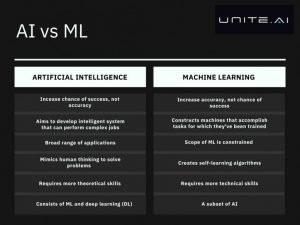Artificial Intelligence
Machine Learning vs Artificial Intelligence: Key Differences

It’s very common to hear the terms “machine learning” and “artificial intelligence” thrown around in the wrong context. It’s an easy mistake to make, as they are two separate but similar concepts that are closely related. With that said, it’s important to note that machine learning, or ML, is a subset of artificial intelligence, or AI.
To understand these two concepts better, let’s first define each one:
- Artificial Intelligence (AI): AI is any software or processes that are designed to mimic human thinking and process information. AI includes a wide range of technologies and fields like computer vision, natural language processing (NLP), autonomous vehicles, robotics, and finally, machine learning. AI enables devices to learn and identify information to solve problems and extract insights.
- Machine Learning (ML): Machine learning is a subset of AI, and it is a technique that involves teaching devices to learn information given to a dataset without human interference. Machine learning algorithms can learn from data over time, improving the accuracy and efficiency of the overall machine learning model. Another way of looking at it is that machine learning is the process that AI undergoes when performing AI functions.
Key Aspects of Artificial Intelligence
Many definitions of artificial intelligence have popped up over the years, which is one of the reasons it can seem somewhat complicated or confusing. But in its simplest form, AI is a field that combines computer science and robust datasets to achieve effective problem-solving.
Today’s field of artificial intelligence includes sub-fields like machine learning and deep learning, which involve AI algorithms that make predictions or classifications based on input data.
AI is sometimes broken down into different types, such as weak AI or strong AI. Weak AI, which is also referred to as Narrow AI or Artificial Narrow Intelligence (ANI), is AI that has been trained to perform specific tasks. It is the most apparent form of AI in our daily lives, enabling applications like Apple’s Siri and autonomous vehicles.
Strong AI consists of Artificial General Intelligence (AGI) and Artificial Super Intelligence (ASI). AGI is only theoretical at this point, and it refers to a machine having intelligence equal to humans. AGI would be self-aware and able to solve highly complex problems, learn, and plan for the future. Taking things even further, ASI would surpass human intelligence and ability.
One of the ways to understand AI is by looking at some of its various applications, which include:
- Speech Recognition: AI is the key to many speech recognition technologies. Also referred to as computer speech recognition or speech-to-text, it relies on NLP to translate human speech into written format.
- Computer Vision: AI enables computers to extract information from digital images, videos, and other visual inputs. Computer vision is used for photo tagging, healthcare imaging, autonomous cars, and much more.
- Customer Service: AI powers chatbots throughout the customer service industry, changing the relationship between businesses and their customers.
- Fraud detection: Financial institutions use AI to spot suspicious transactions.
Key Aspects of Machine Learning
Machine learning algorithms rely on structured data to make predictions. Structured data is data that is labeled, organized, and defined with specific features. Machine learning usually needs this data to be pre-processed and organized, or else it would be taken over by deep learning algorithms, which is yet one more subfield of AI.
When we look at the larger concept of machine learning, it quickly becomes apparent that it’s a highly valuable tool for businesses of all sizes. This is thanks in large part to the massive amount of data available to organizations. Machine learning models process the data and identify patterns that improve business decision making at all levels, and these models update by themselves and improve their analytical accuracy each time.
Machine learning consists of a few different techniques, with each one working differently:
- Supervised Learning: Labeled data “supervises” the algorithms and trains them to classify data and predict outcomes.
- Unsupervised Learning: A machine learning technique that uses unlabeled data. Unsupervised learning models can analyze data and discover patterns without human intervention.
- Reinforcement Learning: This technique trains models to make a sequence of decisions, and it is based on a reward/punishment system.

Difference in AI/ML Skillsets
Now that we have separated the two concepts of artificial intelligence and machine learning, you’ve probably guessed that each one requires a different set of skills. For individuals looking to get involved with AI or ML, it’s important to recognize what is required for each.
When it comes to AI, the skill set tends to be more theoretical rather than technical, while machine learning requires highly technical expertise. With that said, there is some crossover between the two.
Let’s first look at the top skills required for artificial intelligence:
- Data Science: A multidisciplinary field focused on using data to derive insights, data science skills are crucial for AI. They can include everything from programming to mathematics, and they help data scientists use techniques like statistical modeling and data visualizations.
- Robotics: AI provides robots with computer vision to help them navigate and sense their environments.
- Ethics: Anyone involved with AI must be well-versed in all of the ethical implications of such technology. Ethics are one of the main concerns regarding the deployment of AI systems.
- Domain Knowledge: By having domain knowledge, you will understand the industry better. It will also help you develop innovative technologies to address specific challenges and risks, better supporting your business.
- Machine Learning: To truly understand AI and apply it in the best way possible, you should have a solid understanding of machine learning. While you might not need to know every single technical aspect of machine learning development, you should know the fundamental aspects of it.
When we look at machine learning, the skills tend to get far more technical. With that said, it would benefit anyone looking to get involved with AI or ML to know as many of these as possible:
- Programming: Every machine learning professional must be proficient in programming languages like Java, R, Python, C++, and Javascript.
- Mathematics: ML professionals work extensively with algorithms and applied mathematics, which is why they should have strong analytical and problem-solving skills, paired with mathematical knowledge.
- Neural Network Architecture: Neural networks are fundamental to deep learning, which is a subset of machine learning. ML experts have a deep understanding of these neural networks and how they can be applied across sectors.
- Big Data: A major part of machine learning is big data, where these models analyze massive datasets to identify patterns and make predictions. Big data refers to the extraction, management, and analysis of huge amounts of data efficiently.
- Distributed Computing: A branch of computer science, distributed computing is another major part of machine learning. It refers to distributed systems whose components are located on various networked computers, which coordinate their actions by exchanging communications.
These are just some of the AI and ML skills that should be acquired by anyone looking to get involved in the fields. With that said, any business leader would greatly benefit from learning these skills, as it would help them have a better understanding of their AI projects. And one of the major keys to success for any AI project is a competent team of leaders that understands what is taking place.
If you want to learn more about how you can acquire some of these AI or ML skills, check out our list of best data science and machine learning certifications.














